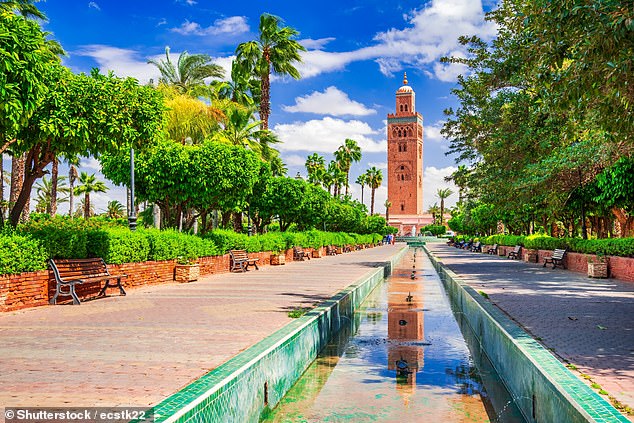As temperatures drop and nights become darker, many travellers have one thing on their mind: booking their next sunny holiday.
It’s becoming increasingly common for Brits to jet off after Christmas, escaping the festivities for lounging by the pool.
Jetting off in dreary January isn’t just a welcome break from the winter chill back home; it also offers low-season prices and crowd-free sightseeing.
Which? has analysed the holiday spots with the highest January temperatures.
Read on to find out the warmest places to go this January, from sunny European spots to long-haul bucket list trips.
Marrakesh
Marrakesh, a former imperial city in western Morocco, is one of the warmest places for a winter getaway and is just a four-hour flight from London.

Koutoubia Mosque minaret at Medina quarter in Marrakesh, Morocco, is pictured
While temperatures peak at the mid-30s during June and July, things become far more comfortable during January at around 18C with no humidity and 10 hours of daylight.
Cultural highlights include the Amazigh New Year, celebrated on January 12, and the Marrakesh marathon at the end of the month.
Seville
Visit anywhere in the Andalusia region of southern Spain and you’ll find plenty of sunshine, even in January.
But during winter, skip the coastal spots like Marbella and Malaga, and head inland to Seville for less of a sea breeze.

Instead of eating Christmas leftovers, you could enjoy watching a January sunset at Plaza de Espana in Seville, Andalusia
During summertime, Seville can be crowded, but by January, the tourists have departed, meaning you’ll have its castles, palaces and cathedrals to enjoy by yourself.
If you’re visiting at the start of the month, don’t miss the Three Kings’ Day parades, complete with colourful floats, live music and lashings of sweets thrown into the street.
Madeira
Thousands of years of volcanic eruptions carved Madeira’s rugged landscape, and you can enjoy it without the crowds in January.

Pictured: The small village of Caniçal in eastern Madeira, Portugal
You’ll touch down in the archipelago’s capital, Funchal, which came joint fourth in a recent Which? survey of the best European city breaks – clinching the maximum five stars for its cultural sights and food and drink.
With a January high of 15C, it’s a great spot for sightseeing, cable car riding and hiking. The 10km climb to the island’s highest peak, Pico Ruvio, is one of the best.
Tenerife
Don’t let its reputation as a party island put you off; Tenerife has so much more to offer.
Beyond the karaoke bars, you’ll find craggy cliff-backed black sand beaches, volcanic landscapes and timeless villages.

In Costa Adeje, Tenerife, you’ll find classy restaurants and boutiques
Costa Adeje came out top in Tenerife in a Which? survey of the best Canary Island resorts.
This quietly upmarket town on the south coast has classy restaurants, designer boutiques, a golf course and average highs of 18C in January – when its waters are home to pilot whales and bottlenose dolphins.
Dominican Republic
Not only is the Dominican Republic one of the Caribbean’s best-value destinations, it ticks all the boxes: blonde beaches, translucent sea, balmy winters.
With a January high of 28C, the Dominican Republic has the Caribbean’s oldest city, Santo Domingo, where you can explore the Spanish colonial quarter’s sleepy streets.

An aerial view of Saona Island in Dominican Republic is pictured
At this time of year, the sheltered waters of the Samana Peninsula are the breeding ground of humpback whales.
Vietnam

Phong Nam Valley, part of the Non Nuoc Cao Bang UNESCO Global Geopark in Vietnam, is pictured
In Vietnam’s largest metropolis, Ho Chi Minh City, history seeps from every temple and elegantly restored colonial villa.
January is typically the driest, least sticky month. But if it’s still too hot in the city, the Mekong Delta and the beautiful beach-lined Phú Quốc and Côn Đảo islands are within easy reach.
The capital, Hanoi, is more laid back and much cooler, with January highs of 20C.
Namibia
January in Namibia is the peak of summer, characterised by hot, humid weather, with temperatures of around 30C.

Pictured: The Etosha National Park in Namibia, Namib desert, Africa
It is the rainy season, though rain typically falls as short, late-afternoon thunderstorms after clear mornings, making the landscape lush and green.
This makes it an excellent time for birdwatching and enjoying green scenery but visitors should be prepared for the heat and occasional downpours.
The dusty savannah in Etosha National Park turns green, and you can spot springbok, zebra and wildebeest with their newborn.
Expect cooler temperatures on the Skeleton Coast, where cape fur seals and their plump pups loll at Cape Cross.
This article was originally published by a www.dailymail.co.uk . Read the Original article here. .

